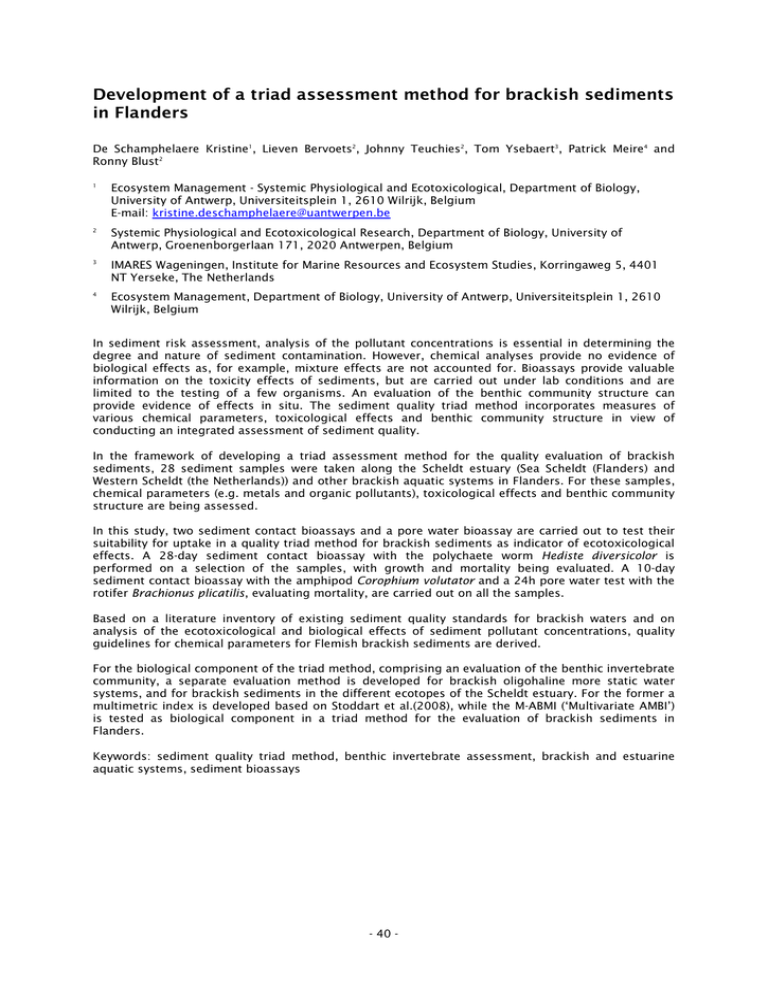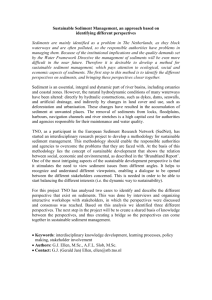Development of a triad assessment method for brackish sediments in Flanders
advertisement

Development of a triad assessment method for brackish sediments in Flanders De Schamphelaere Kristine1, Lieven Bervoets2, Johnny Teuchies2, Tom Ysebaert3, Patrick Meire4 and Ronny Blust2 1 Ecosystem Management - Systemic Physiological and Ecotoxicological, Department of Biology, University of Antwerp, Universiteitsplein 1, 2610 Wilrijk, Belgium E-mail: kristine.deschamphelaere@uantwerpen.be 2 Systemic Physiological and Ecotoxicological Research, Department of Biology, University of Antwerp, Groenenborgerlaan 171, 2020 Antwerpen, Belgium 3 IMARES Wageningen, Institute for Marine Resources and Ecosystem Studies, Korringaweg 5, 4401 NT Yerseke, The Netherlands 4 Ecosystem Management, Department of Biology, University of Antwerp, Universiteitsplein 1, 2610 Wilrijk, Belgium In sediment risk assessment, analysis of the pollutant concentrations is essential in determining the degree and nature of sediment contamination. However, chemical analyses provide no evidence of biological effects as, for example, mixture effects are not accounted for. Bioassays provide valuable information on the toxicity effects of sediments, but are carried out under lab conditions and are limited to the testing of a few organisms. An evaluation of the benthic community structure can provide evidence of effects in situ. The sediment quality triad method incorporates measures of various chemical parameters, toxicological effects and benthic community structure in view of conducting an integrated assessment of sediment quality. In the framework of developing a triad assessment method for the quality evaluation of brackish sediments, 28 sediment samples were taken along the Scheldt estuary (Sea Scheldt (Flanders) and Western Scheldt (the Netherlands)) and other brackish aquatic systems in Flanders. For these samples, chemical parameters (e.g. metals and organic pollutants), toxicological effects and benthic community structure are being assessed. In this study, two sediment contact bioassays and a pore water bioassay are carried out to test their suitability for uptake in a quality triad method for brackish sediments as indicator of ecotoxicological effects. A 28-day sediment contact bioassay with the polychaete worm Hediste diversicolor is performed on a selection of the samples, with growth and mortality being evaluated. A 10-day sediment contact bioassay with the amphipod Corophium volutator and a 24h pore water test with the rotifer Brachionus plicatilis, evaluating mortality, are carried out on all the samples. Based on a literature inventory of existing sediment quality standards for brackish waters and on analysis of the ecotoxicological and biological effects of sediment pollutant concentrations, quality guidelines for chemical parameters for Flemish brackish sediments are derived. For the biological component of the triad method, comprising an evaluation of the benthic invertebrate community, a separate evaluation method is developed for brackish oligohaline more static water systems, and for brackish sediments in the different ecotopes of the Scheldt estuary. For the former a multimetric index is developed based on Stoddart et al.(2008), while the M-ABMI (‘Multivariate AMBI’) is tested as biological component in a triad method for the evaluation of brackish sediments in Flanders. Keywords: sediment quality triad method, benthic invertebrate assessment, brackish and estuarine aquatic systems, sediment bioassays - 40 -






